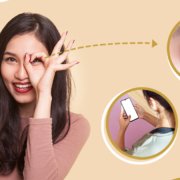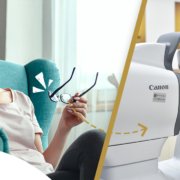Protecting Your Eyes At The Office
Are you an office person? For sure, your eyes are fully used for each of your work days.
On average, a typical Filipino adult spends an estimated eight hours staring at digital devices on a daily basis. This unprecedented level of screen time has caused a dramatic increase in the number of people suffering from digital eye strain. In fact, approximately 70 percent of working adults, who use a computer on a daily basis, suffer from digital eye strain.
In a world where your job depends on using digital devices, the following tips can help you protect your eyes and relieve digital eye strain while you are in the office.
TIP #1: Organize your Workspace
Did you know that preventing digital eye strain begins with the distance that you keep between your eyes and your tablet, computer, and smartphone screen? The ideal distance between your desktop or laptop and your eyes should be approximately one arm’s length. Additionally, the center of your computer’s screen should be between 10 and 15 degrees below your eye level to increase back and neck comfort. If the majority of your work is completed on a smartphone or tablet, then you should try to keep the devices 16 to 18 inches away from your eyes to reduce digital eye strain.
TIP #2: Always Use Proper Lighting
Whether it is from harsh overhead lighting or an abundance of natural light that causes you to squint at your computer’s screen, the wrong lighting can strain your eyes. To reduce eye strain you can implement the following tips.
Set your computer’s brightness to match your surroundings. In other words, your computer’s screen shouldn’t be so dim that you are squinting to see it, nor should it be so bright that it serves as a beacon in an otherwise neutrally lit room. Don’t forget to also adjust the brightness on your smartphone and tablet.
Use drapes and blinds to reduce natural light (as needed).
Reposition your computer screen to avoid glare.
TIP #3: Modify Your Device’s Settings
In addition to adjusting the brightness on your devices, you can also modify settings to help prevent digital eye strain.
Try enlarging the text size on all of your devices.
— As a general rule of thumb, the smaller the text, the harder your eyes have to work.
Reduce the amount of blue light that your devices emit.
— Blue light is associated with higher rates of eye strain, which means that choosing another hue, such as red or orange, can help you to protect your eyes.
Set “device break” reminders throughout the day.
— Give your eyes a break from screens by looking away from your computer at something that is 20 feet away for at least 20 seconds. Try to give your eyes a break at least once every 20 minutes. If you can’t give your eyes a break every 20 minutes, then remember to blink more, which will give your eyes the moisture and nutrients that they need to stay healthy and lubricated.
Have you begun to feel the effects of digital eye strain? If your eyes are becoming irritated from prolonged daily exposure to digital screens, then you should schedule an eye appointment today with our experienced eye specialists in one of our clinics.
Our team will help you recover from digital eye strain, and suggest additional ways that you can protect your eyes while working.
For inquiries, questions, and appointments, call our Patient Care Lines:
🖥 Talk to our Consultants via Livechat: https://shinagawa.ph/
📱 Instagram: https://instagram.com/shinagawa_ph/






